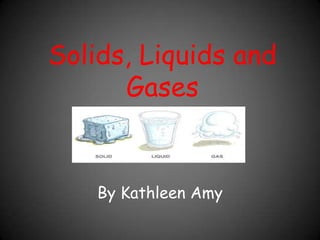
Solids liquid gases
- 1. Solids, Liquids and Gases By Kathleen Amy
- 2. Solids One of the major states of matter A solid does not take the shape of its container Atoms in a solid are tightly bound together
- 3. Liquids Second major state of matter Liquids can flow Liquids take the shape of their container Atoms in a liquid are loosely bound.
- 4. Gases Third major state of matter Gases have no shape or size of their own Gases are all around us. Gas particles can move past each other.
- 5. Changing of Matter All matter can change from one state to another. In order for matter to change form, it may require very low temperatures, very high temperatures, or high pressure.
- 6. How to Change Water to a Solid, Liquid, and Gas Water can be changed to a solid when it reaches its freezing point Water can be changed to a liquid when it reaches its melting point Water can be changed to a gas when it reaches its boiling point.
- 7. Resources Solid, Liquid, and Gas Game
- 8. Content Standards First Grade Physical Science Materials come in different forms including solids, liquids, and gases. A. Students know solids, liquids, and gases have different properties. B. Students know the properties of a substance can change when the substance is heated, cooled, or mixed.